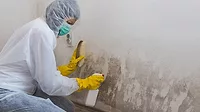Saving the Heart of Country Music: A firsthand account of the Nashville flooding

It was late as the plane banked toward the airport runway. I peered out the window to see a wide, winding black strip – which I later learned was the swollen Cumberland River – bisecting Nashville.
Much of the downtown area near the river was dark. Over a foot of rain had poured down over the May Day weekend and within hours, the ensuing flood wiped out hundreds of homes and businesses for miles. The storm had lead to more than 30 deaths in a three-state area and more than a billion dollars in property damage. The locals were still in shock as the water had not yet begun to recede. Business as usual would be a long-time coming.
Around midnight, I checked into my hotel room literally at the flood water’s edge. This area, Bellevue, was the hardest hit. There were dozens of restoration vehicles in the parking lot, with a few contractors still fussing over their equipment in preparation for tomorrow’s battle with the devastation.

I am a consultant for a company that performs administrative and operational support to restoration and insurance companies, as well as victims of the loss. Part of our work consists of ensuring compliance with the IICRC’s S500 Water Damage Restoration Standard, tracking equipment and manpower, auditing work performed, plotting drying progress and air filtration flows and making appropriate recommendations.
Most of us understand the relationship between insurance adjusters, property owners and restorers. On a typical residential loss, the adjuster’s goal is to serve the client’s interests at the least possible cost. The restorer wants to serve the client’s interests while making a reasonable profit, and the client just wants things returned to the way they were as quickly as possible.

One thing is for sure. It is shocking just how much money is “left on the table” through the restorer’s failure to track and justify their work. Careful documentation eases the collection process, and following the Standards provides justification for the services you provide. Failure to follow the Standards will not only result in lost restoration income, but usually increases the amount of unnecessary losses due to continuing damage.

Country music’s Mecca, the Grand Ole Opry, was hit hard. Although a team worked tirelessly to move irreplaceable historic items to higher ground, many of the rhinestone studded costumes, antique amplifiers and guitars from back stage or in glass display cases in the lobby had been damaged beyond repair. Most of the audio and videotapes along with archival photographs were able to be save, as were numerous items on display in the Grand Ole Opry Museum.

By the time the Cumberland had crested, water covered the stage and was spreading throughout the building. Although the rest of the stage has now been thrown away, Nashville’s famous circle was cut out once again and taken in for careful restoration; it will be refurbished and returned to center stage when the Grand Ole Opry reopens late this fall. The Opryland Hotel is part of the Gaylord Opryland Resort and Convention Center, a large complex including retail stores and several atria. The posh resort is situated in a low spot near the Cumberland River. At 10 p.m. on May 2, word came that water had breached the levee. Thousands of guests and visitors were enjoying the peace and tranquility of the famous vacation site. Suddenly, they were being rushed out of harm’s way and evacuated as quickly as possible while hotel employees scrambled to secure their areas and get out too.

The 4-star facility is thought to be the largest non-casino hotel in the world and the largest hotel in the United States outside of Las Vegas. With 6 full-service restaurants, 3 lounges, 8 eateries, 14 retail stores, a nightclub and many bars, this was the mother of all restoration projects with millions of additional dollars in potential losses at stake.
Rivers flow. Flooded rivers flow faster, and I found it amazing that some of the palm trees inside of the hotel had been knocked down, and the river boats that navigated the property’s indoor river were washed up into priceless tropical gardens.

Planning and logistics were top priorities for the mitigation teams. Working up to 16 hours every day, seven days a week, teams of professional restorers rose to the occasion. Living on adrenaline, I saw the best come out in them as they tackled the seemingly impossible task. Days after the loss, it still appeared as though they were barely scratching the surface of work ahead.
The goal was to bring the property back to pre-loss condition as quickly as possible while preventing continuing damage. On projects of this size, even small flaws in the decision-making process can cost hundreds of thousands of dollars in needless replacement costs. There were monumental challenges everywhere. Pumps placed to suck the water out were barely making headway as water continued to flow in from everywhere. Days later, the still-saturated soil around the building began to exert tremendous inward pressure on the foundation walls of the six-story structure. Measured water removal was employed to decrease the risk of collapsing the entire building.

Encircling the mammoth structure were more than 50 large desiccant machines supported by dozens of generators and huge air chillers. Power cords ran across the ground like large, black spaghetti, reminiscent of the midway at a state fair.
These desiccant units are designed to pump warm, dry air into flooded structures. A typical machine will deliver 6,000 cubic feet of this conditioned air every minute. The largest unit we had onsite puts out nearly 25,000 cfm displacing and removing moisture from the air. I measured the exhaust of this giant at over 240 grains per pound of moisture.
Dwarfed by the size of the structure, miles of 18- and 24-inch “layflat” poly tubing delivered warm, dry air to the still dripping interior. Large air “scrubbers” and countless air movers mixed this air in an attempt to return the structure to the dry standard as quickly as possible.
By the time you read this, our work will have long been completed and renovations will be well underway. With an expected opening date of November, the total cost to remediate and rebuild the plush resort are expected to exceed $200 million.
Damage estimates for Nashville alone now exceed $1.5 billion. Nearly 10,000 properties are damaged. 2,000 of those are residences. Unfortunately, virtually all of the homes were un-insured for this once-in-a-lifetime disaster leaving overwhelmed homeowners fending for themselves.
Tragedies such as this one seem to be happening more frequently and when they do, the cat loss specialist will be there doing what they can to rescue the properties.
Looking for a reprint of this article?
From high-res PDFs to custom plaques, order your copy today!








